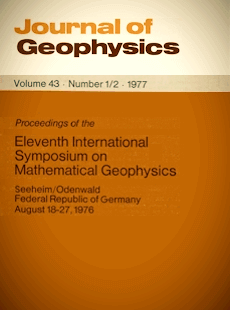Elastic wave propagation in a highly scattering medium - a diffusion approach
Article Sidebar

Vols. 1-18 (1924-1944), ISSN 0044-2801
Main Article Content
Abstract
The principle of conservation of energy, in the form of the equation of radiative transfer, is used to treat the case of strong scattering of elastic waves. If the medium is isotropic, if all the energy present has been scattered many times, and if the time and distance scales of the problem are long compared to the time and distance scales of the scattering process, then the average flow of energy is described by the diffusion equation with an additional term representing linear dissipation to heat. Model seismic experiments using holes drilled in aluminum plates as scatterers confirm the applicability of the formalism. The diffusion formalism qas been successfully applied to lunar seismograms and to some Earth data. The results of studies of lunar seismograms show that the zone of strong scattering on the Moon is confined to a near surface zone.
 ARK: https://n2t.net/ark:/88439/y064280
ARK: https://n2t.net/ark:/88439/y064280
Permalink: https://geophysicsjournal.com/article/102
Article Details
References
Aki, K., Chouet, B. (1975) Origin of coda waves: source, attenuation and scattering effects. J. Geophys. Res. 80:3322-3342
Berckhemer, H. (1970) A possible scattering mechanism for lunar seismic waves. J. Geophys. 36:523-529
Carslaw, H.S., Jaeger, J.C. (1959) Conduction of heat in solids, 2nd ed. Oxford University Press, London
Chandrasekhar, S. (1960) Radiative transfer. Dover, New York
Chernov, L.A. (1960) Wave propagation in a random medium. McGraw-Hill, New York
Cleary, J.R., Haddon, R.A.W. (1972) Seismic wave scattering near the core-mantle boundary: a new interpretation of precursors to PKIKP. Nature 240:549-550
Dainty, A.M., Toksoz, M.N., Anderson, K.R., Pines, PJ., Nakamura, Y., Latham, G. (1974) Seismic scattering and shallow structure of the Moon in Oceanus Procellarum. The Moon 9:11-29
Jeans, J.H. (1925) The dynamical theory of gases, 4th ed. Cambridge University Press, London
Knopoff, L., Hudson, J.A. (1964) Scattering of elastic waves by small inhomogeneities. J. Acoust. Soc. Am. 36:338-345
Latham, G.V., Ewing, M., Press, F., Sutton, G., Dorman, J., Nakamura, Y., Toksoz, N., Wiggins, R., Derr, J., Duennebier, F. (1970) Passive seismic experiment. Science 167:435-457
Latham, G.V., Ewing, M., Press, F., Sutton, G., Dorman, J., Nakamura, Y., Toksoz, N., Duennebier, F., Lammlein, D. (1971) Passive seismic experiment, Apollo 14 Preliminary Science Report. NASA SP-272:133-161
Latham, G.V., Ewing, M., Press, F., Sutton, G., Dorman, J., Nakamura, Y., Toksoz, N., Lammlein, D., Duennebier, F. (1972) Passive seismic experiment, Apollo 16 Preliminary Science Report. NASA SP-315, Section 9
Nakamura, Y. (1976) Seismic energy transmission in the lunar surface zone determined from signals generated by movement of lunar rover. Bull. Seism. Soc. Amer. 66:593-606
Nakamura, Y., Latham, G.V., Ewing, M., Dorman, J. (1970) Lunar seismic energy transmission. EOS 51:776 (abs.)
Pines, P.J. (1973) Model seismic studies of intensely scattering media. M.Sc. Thesis, MIT
Tittman, B.R., Curnow, J.M., Housely, R.M. (1975) Internal friction quality factor Q~3100 achieved in lunar rock 70215, 85, Proc. Sixth Lunar Sci. Conf., Vol. 3, pp. 3217-3226. Pergamon Press, New York
Toksoz, M.N., Dainty, A.M., Solomon, S.C., Anderson, K.R. (1974) Structure of the Moon. Rev. Geophys. Space Phys. 12:539-567
Wesley, J.P. (1965) Diffusion of seismic energy in the near range. J. Geophys. Res. 70:5099-5106











